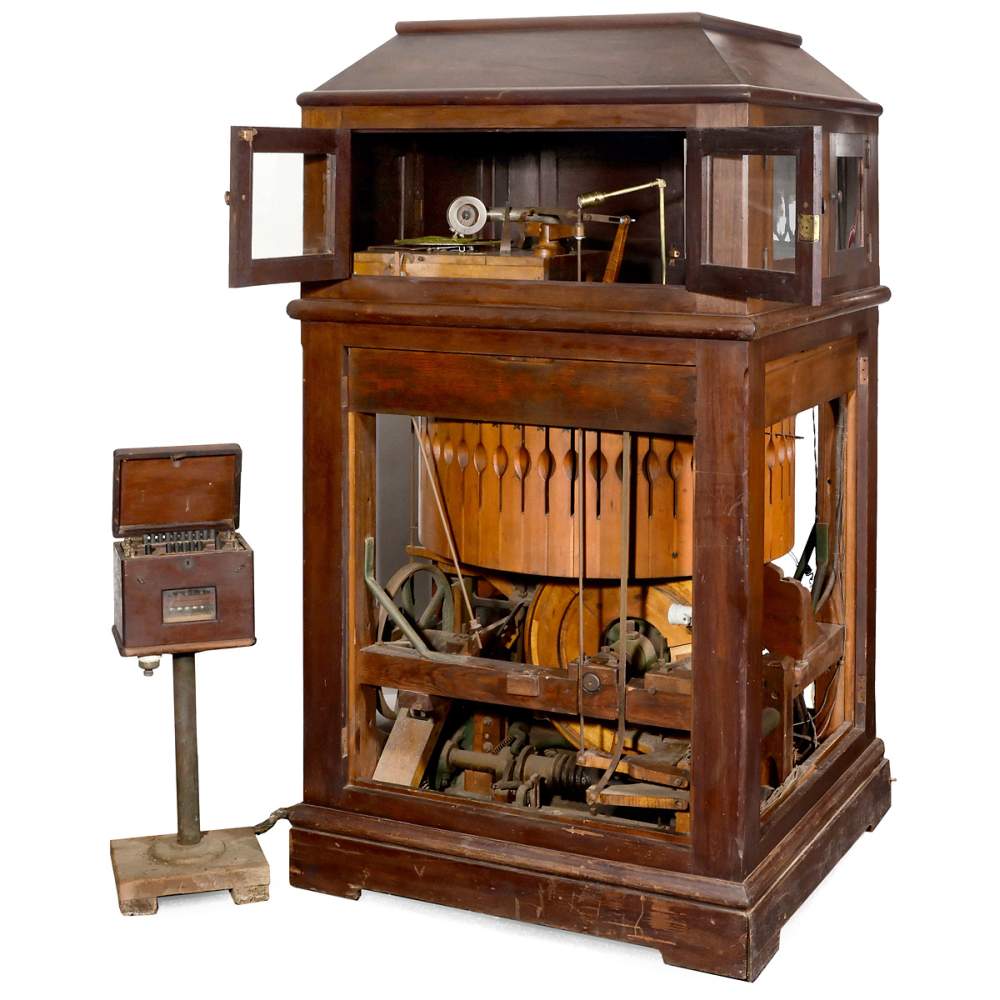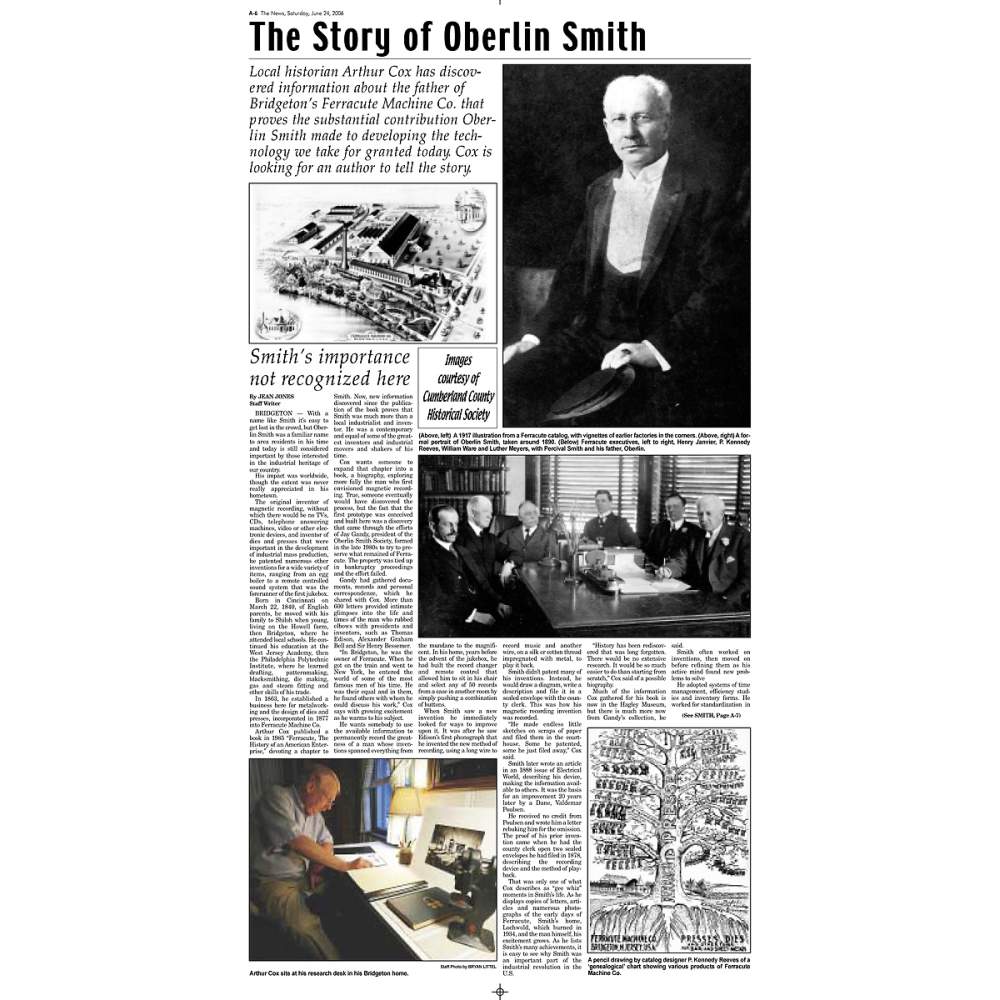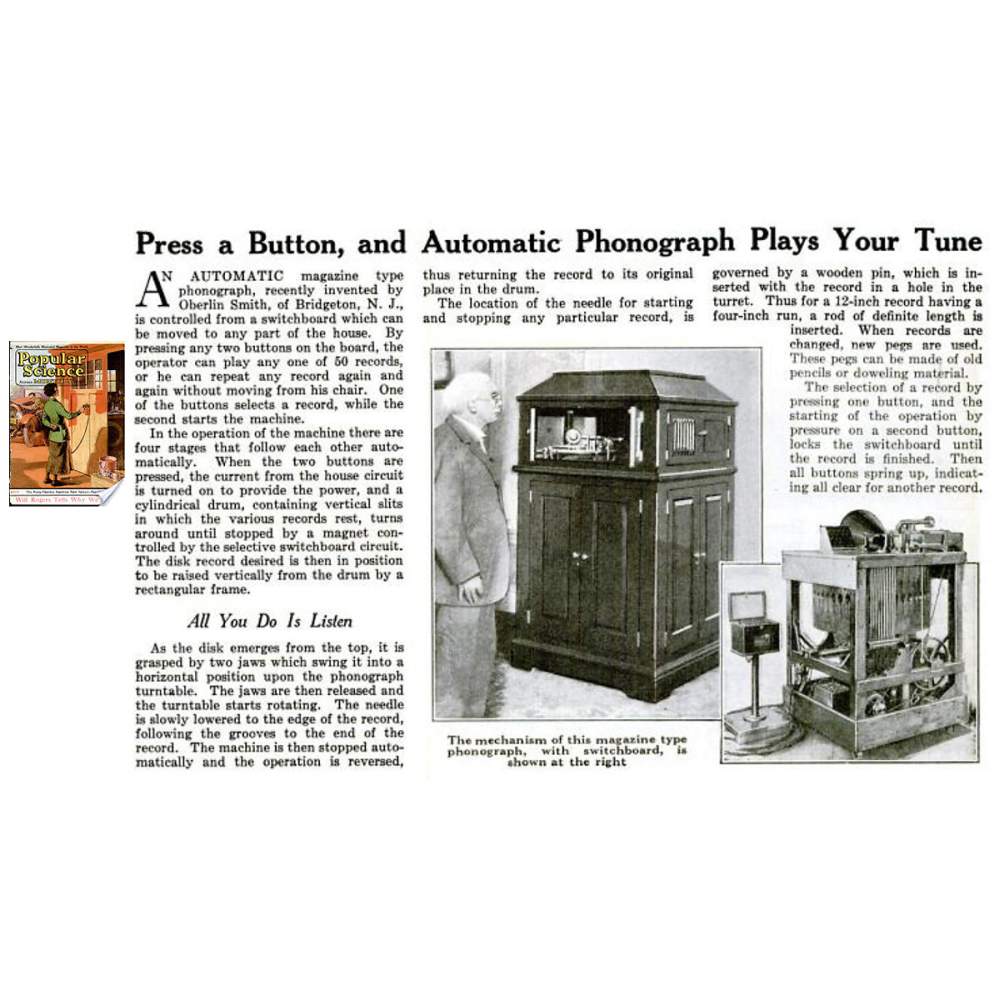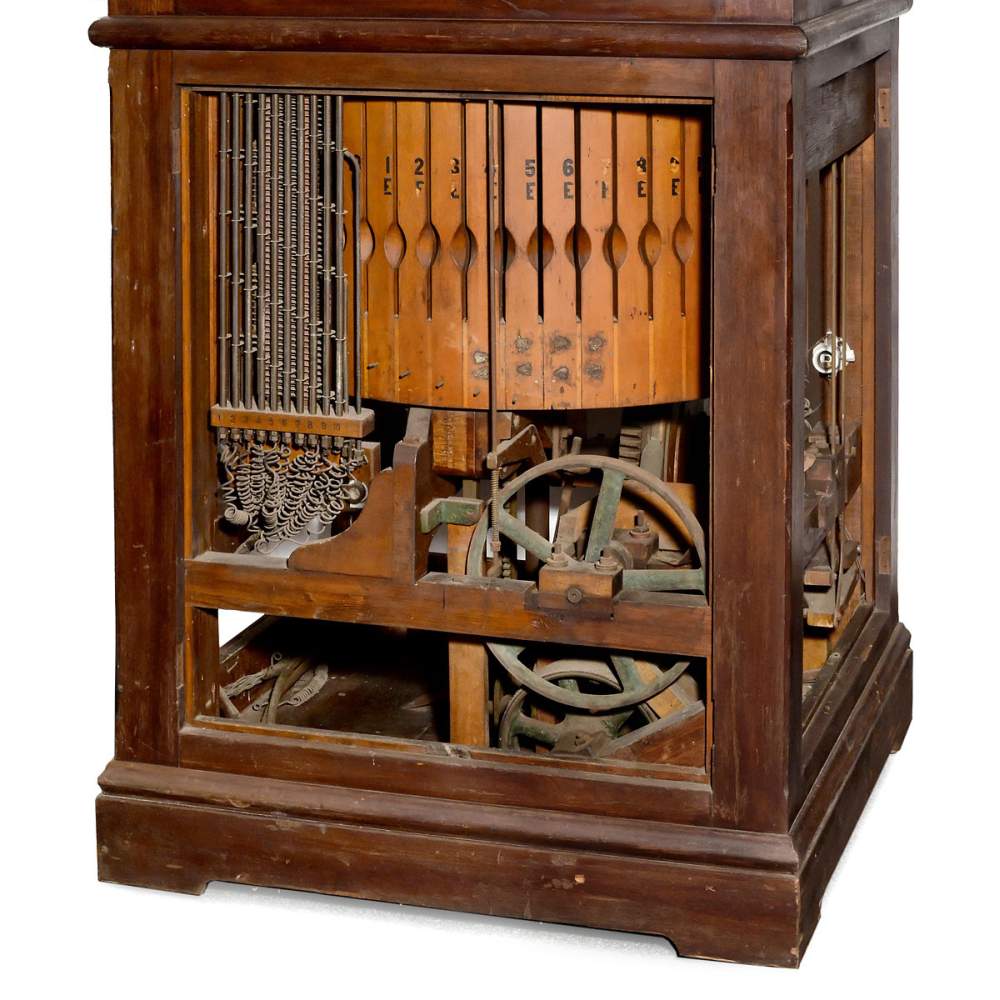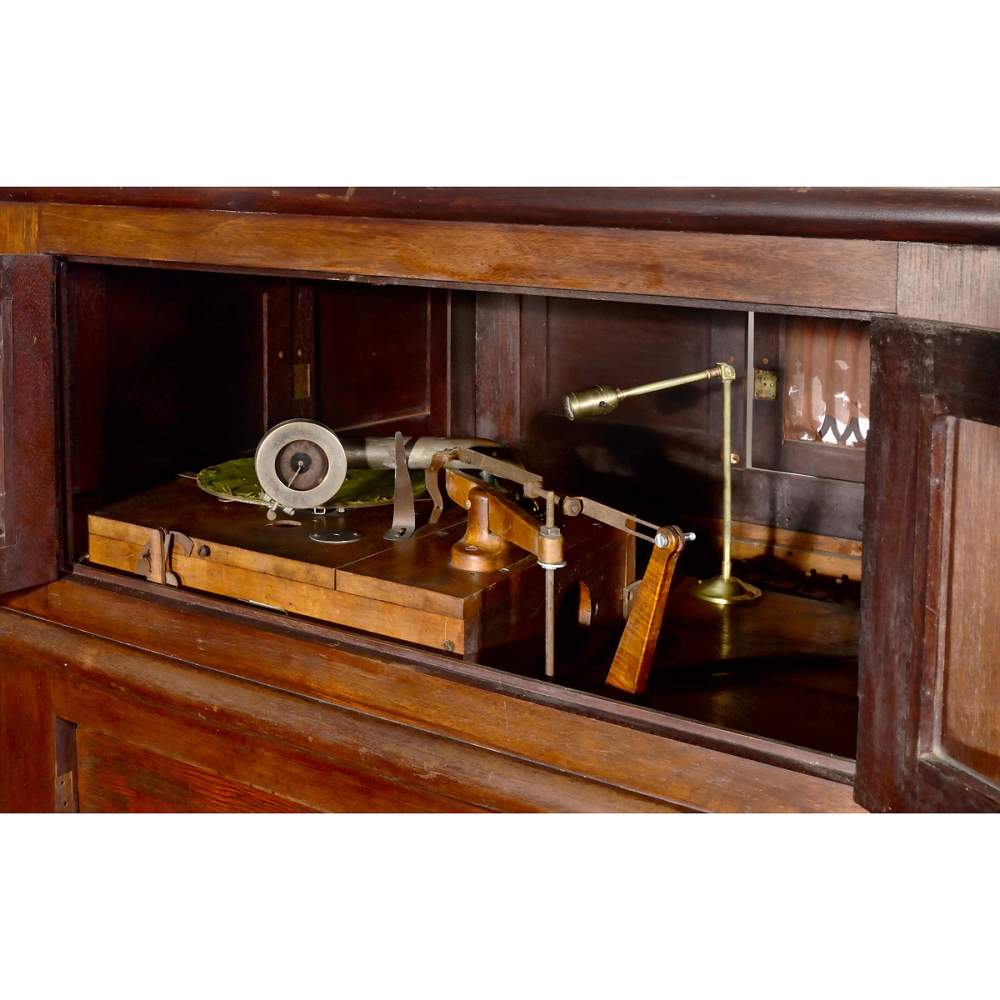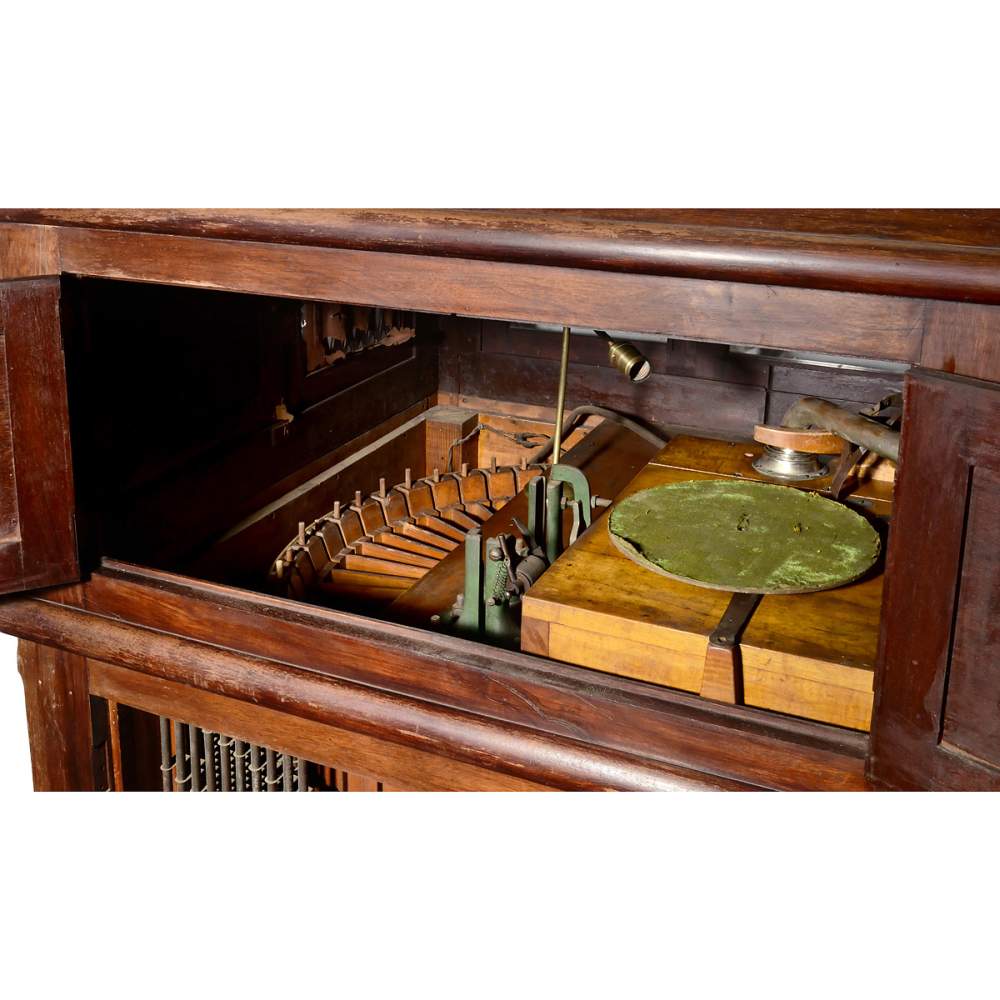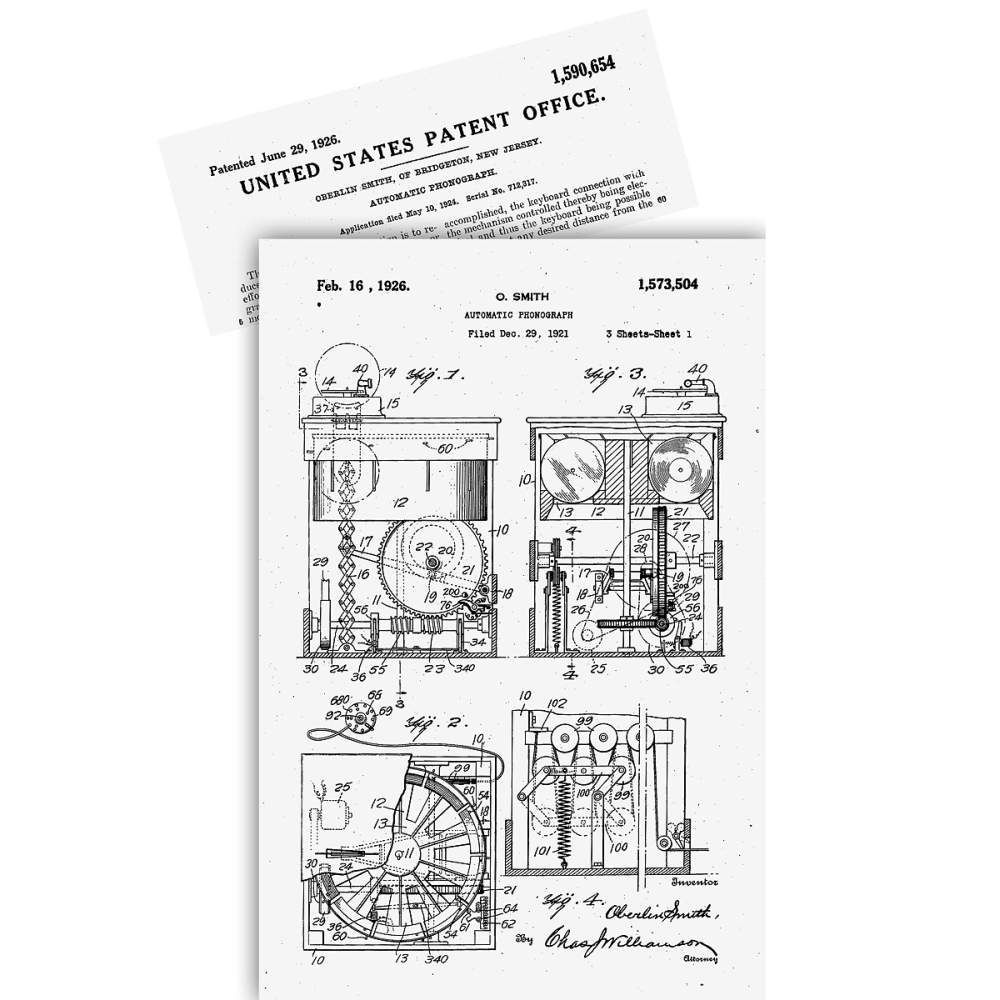446
An Historically Important Jukebox Forerunner by the Inventor of Magnetic Recording, Oberlin Smith (
Oberlin Smith and the Genus of Magnetic Recording: Oberlin Smith was born in Cincinnati, Ohio, but spent most of his adult life in Bridgeport, New Jersey, where he established a business designing dies and presses. The Ferracute Machine Co., incorporated in 1877, built presses for hundreds of metal products from artillery shells to the first commercial oil cans, stamping out components for Packards, Winchester rifles and Kodak cameras. Through his work, Smith came into contact with inventors such as Thomas Edison and Alexander Graham Bell. - In 1877 Thomas Edison gave the first public demonstration of his tinfoil phonograph for recording and reproducing sound mechanically. Smith travelled to Edison's laboratory to see and hear the device in person. - Smith was disturbed by the scratching noises and by the limited length of the recording medium. Less than a year later, he filed two improvements to the phonograph and a provisional description of an electrical phonograph with the Cumberland County Clerk in a memorandum dated 23rd September 1878 and on 4th October 1878 filed a caveat at the United States Patent Office. - The first of improvement was to record phonograph signals on a long wire stored on reels, enabling extended pieces of music to be recorded. The second was to store the sound as a magnetic signal on a silk or cotton thread impregnated with metal powder. - According to Smith, his form of magnetic recording would produce "a perfect record of the sound, far more delicate that the indentations in the tin-foil of the mechanical phonograph". Smith continued to experiment with magnetic recordings over the next decade, publishing his ideas in an article titled "Some Possible Forms of Phonograph" in the influential "Electrical World" journal on 8th September 1888. - Despite Smith's prior work in the field, the Danish inventor Valdemar Poulsen (1869-1942) was credited as the first person to achieve magnetic sound recording with operational, mass-produced equipment. Poulsen filed a patent for a "method of recording and reproducing sound or signals" by "magnetically exciting paramagnetic bodies" on 8th July 1899. The patent was granted on 13 November 1900 and unveiled to the public with a recording of Kaiser Franz Joseph's voice at the Paris Exposition of the same year. - Poulsen certainly knew of Smith's work as the 1888 article from "Electrical World" was cited during the patent grant procedure, however Smith received no public credit from Poulsen. Smith reacted to Poulsen's omission by laying retrospective claim to the invention of magnetic recording in an application to U.S. Commissioner of Patents in Washington in November 1900. However, as he head filed only a caveat (and not a patent) in 1878, his claim was not taken seriously. - Not only did Smith's work raise the idea of a recording telephone, it also paved the way for developments in universal magnetic storage of sound, images and data still in use more than one hundred years later. Without Smith, much of today's magnetic recording technology - from the hard-drive to the magnetic strips of credit cards - would not have been possible. Smith's Last Invention: The Autofono - "All You Do is Listen " Despite his disappointments in the field of magnetic recording, Smith did not give up his experiments with magnetic technology. On 29th December 1921, Smith filed a patent application for an "Automatic Phonograph". - "The main object of my invention is to reduce to the minimum the manual labor or effort required in the operation of phonographs and other instruments of entertainment ... Another object is to enable the application of the sound record ... by the manipulation of a controlling device, such as a keyboard, situated more or less remote from the instrument." - The patent was finally granted on 16th February 1926 and a second patent for an
Oberlin Smith and the Genus of Magnetic Recording: Oberlin Smith was born in Cincinnati, Ohio, but spent most of his adult life in Bridgeport, New Jersey, where he established a business designing dies and presses. The Ferracute Machine Co., incorporated in 1877, built presses for hundreds of metal products from artillery shells to the first commercial oil cans, stamping out components for Packards, Winchester rifles and Kodak cameras. Through his work, Smith came into contact with inventors such as Thomas Edison and Alexander Graham Bell. - In 1877 Thomas Edison gave the first public demonstration of his tinfoil phonograph for recording and reproducing sound mechanically. Smith travelled to Edison's laboratory to see and hear the device in person. - Smith was disturbed by the scratching noises and by the limited length of the recording medium. Less than a year later, he filed two improvements to the phonograph and a provisional description of an electrical phonograph with the Cumberland County Clerk in a memorandum dated 23rd September 1878 and on 4th October 1878 filed a caveat at the United States Patent Office. - The first of improvement was to record phonograph signals on a long wire stored on reels, enabling extended pieces of music to be recorded. The second was to store the sound as a magnetic signal on a silk or cotton thread impregnated with metal powder. - According to Smith, his form of magnetic recording would produce "a perfect record of the sound, far more delicate that the indentations in the tin-foil of the mechanical phonograph". Smith continued to experiment with magnetic recordings over the next decade, publishing his ideas in an article titled "Some Possible Forms of Phonograph" in the influential "Electrical World" journal on 8th September 1888. - Despite Smith's prior work in the field, the Danish inventor Valdemar Poulsen (1869-1942) was credited as the first person to achieve magnetic sound recording with operational, mass-produced equipment. Poulsen filed a patent for a "method of recording and reproducing sound or signals" by "magnetically exciting paramagnetic bodies" on 8th July 1899. The patent was granted on 13 November 1900 and unveiled to the public with a recording of Kaiser Franz Joseph's voice at the Paris Exposition of the same year. - Poulsen certainly knew of Smith's work as the 1888 article from "Electrical World" was cited during the patent grant procedure, however Smith received no public credit from Poulsen. Smith reacted to Poulsen's omission by laying retrospective claim to the invention of magnetic recording in an application to U.S. Commissioner of Patents in Washington in November 1900. However, as he head filed only a caveat (and not a patent) in 1878, his claim was not taken seriously. - Not only did Smith's work raise the idea of a recording telephone, it also paved the way for developments in universal magnetic storage of sound, images and data still in use more than one hundred years later. Without Smith, much of today's magnetic recording technology - from the hard-drive to the magnetic strips of credit cards - would not have been possible. Smith's Last Invention: The Autofono - "All You Do is Listen " Despite his disappointments in the field of magnetic recording, Smith did not give up his experiments with magnetic technology. On 29th December 1921, Smith filed a patent application for an "Automatic Phonograph". - "The main object of my invention is to reduce to the minimum the manual labor or effort required in the operation of phonographs and other instruments of entertainment ... Another object is to enable the application of the sound record ... by the manipulation of a controlling device, such as a keyboard, situated more or less remote from the instrument." - The patent was finally granted on 16th February 1926 and a second patent for an
»Office Antiques«»Science & Technology«»Fine Toys & Automata«
Sale Date(s)
Venue Address
General delivery information available from the auctioneer
Local Pick-Up, In-House Shipping
Important Information
19.3 % premium + 19 % VAT.
Terms & Conditions
Auction conditions
1) The auction is carried out voluntarily under foreign name and on account of the customer.
2) The goods to be sold in the auction can be and risk of the interested client. They will be put up for auction in the conditions as examined and checked at determined times before the auction – under the full responsibility they are without any liability for visible or hidden defects as well as for attributes; later claims of any kind cannot be taken into consideration. The description in the catalogues are made to the best of our knowledge, but they are no guaranteed attributes in the sense of § 459 and following BGB. – Information
ref. § 26 UStR is assured. – No right of return of any sold item, therefore please use the advantage of the
previewing (also by your friends).
3) Normally the bids are increased in steps of 10 % of the initial price with a minimum of € 5.–. The auctioneer can deviate from this regulation in particular cases. The knocking down is done if no higher offer is made after the third repetition of the highest offer and if the limit price has been achieved.
4) The auctioneer can combine numbers, separate them, can offer them out of the sequence or can withdraw them. The bidding is done by showing the bidding number or by a written offer.
5) The auctioneer can refuse an offer; in this case the offer given right before remains binding. In case several persons make the same offer, the knocking down is decided by lot. In case of identical written offers, the computer makes the decision to the benefit of the first offer received. Decisive in this case is the point of time of its entry. If there is a disagreement on a knocking down or if an offer is made in time has been disregarded, the auctioneer can all the same knock down this bid and can follow-up the rights resulting out of this. He can also knock down to the next lowest bid or can start again with the initial bid of this lot.
6) The knocking down is binding. The goods must be immediately paid. The knocking down transfers the risk of possible losses, damages, mistakes to the purchaser. Each bidder buys in his own name and for his own account.
7) A premium of 19,3 % has to be paid on the knocking down price. The tax (19 %) has to be paid on the surcharge, i.e. the total surcharge amounts to 22,97 %. The entire amount, which has to be paid by the purchaser, is immediately due and has either to be settled in cash, wire transfer or by guaranteed bank draft. In case of an acquisition by submittance of a written order, the payment has to be settled within 8 days after the invoice date.
8) The goods become the property of the purchaser only after the complete payment. The objects will only be delivered if the payment has been settled. Otherwise the goods are still the property of the consigner until complete payment. In case a payment does not reach the auctioneer in due time, the purchaser is liable without reminder for all resulting losses. Also without proof of a loss the interest for delay at the bank usual rate can be charged.
9) In case the payment is not settled in time or the objects are not taken, the auctioneer has the right either to demand the performance of the contract of purchase or can claim damages due to the non-performance. Independent from the above the auctioneer can also put this object for auction in one of the next auctions on cost of the purchaser. For the resale in the auction the bidder is treated as supplier and has to pay the corresponding order commission as well as the tax to be paid on it. All transportation and storing costs as well as possible charges for the employment of additional workers, which result in connection with the above, will be deducted from the net profits. The remaining profit will be balanced on the date of the actual inpayment with the
claim for damages acc. to § 367 BGB.
10) The handing over of the objects bought in the auction is done at any time during and after the auction against presentation of the receipt. Invoices issued immediately after the auction are subject to the right of verification and possible corrections: errors excepted. Bidders who are present at the auction must arrange the
pick-up on the day of the auction. Otherwise the objects will be stored on account and risk of the purchaser without any further notice. The auctioneer does not bear the risk of storing.
11) Each shipment is carried out on the account and risk of the purchaser C.O.D. Insurance possible on request. 12) Bidder orders are handled with great care; a guarantee for its setting up for auction can only be ensured if the written bidding order has reached the auctioneer latest at 12:00 am (noon) two days before the auction. The bidders un-known to the auctioneer are kindly asked to provide a satisfactory security before the auction.
13) The legal relation is based on the German law. Place of performance and legal venue for the mutual trade business is Cologne.
14) The visitor accepts the above conditions explicitly by his participation of the auction or by his offer.
Auction Team Breker
– Astrid & Uwe Breker –
Special notice:
Description of lots are supplemented by additional information (from/to) about usual prices on the international collectors’ market in order to provide a yardstick for any customers. The indicated dates are the years of market introduction of the specific models.
The “Breker-Scale” distinguishes between optical (external) and technical (functional) condition on a scale from 1 to 6 (“very good” to “deficient”) and is described in brackets as follows: (3/2), meaning: optical “3” (satisfactory) and technical “2” (good). The evaluation of condition is defined as follows:
1) very good (unused, no traces of use)
2) good (like new, slight traces of use)
3) satisfactory (normal traces of use)
4) sufficient (strong traces of use, immaterial parts added)
5) poor (defect, strong traces of use, important parts exchanged, needs repair)
6) deficient (totally defect, important parts missing, heavily damaged)
All these informations are worked out seriously but without any guarantee. Technical apparatus, cameras and lenses are offered as collectors’ items – without any guarantee for the mechanical or electrical function. We will
describe faults which we realized. We don’t check electrical machines, apparatus, batteries, photographical accessories (as lightmeters, rangefinders or selftimers etc.) – No right of return of any sold item, therefore please use the advantage of the previewing (also by your friends).
Telephone bids are possible for lots with limits of more than € 500.–, they have to be confirmed in written form up to the day before the auction 12 am. There is no guarantee for a real phone connection.
Auction participants and bidders must understand that purchase of the catalogue or Third Reich items may be done for educational purposes only. In order to repell unconstitutional movements they must be used only for art, science, research and teaching history or related subjects (§§ 86a, 86 StGB). Auction Team Breker as well as their auctioneers and consigners offer these items only under the above conditions. List of realized prices (Internet and next catalogue).















